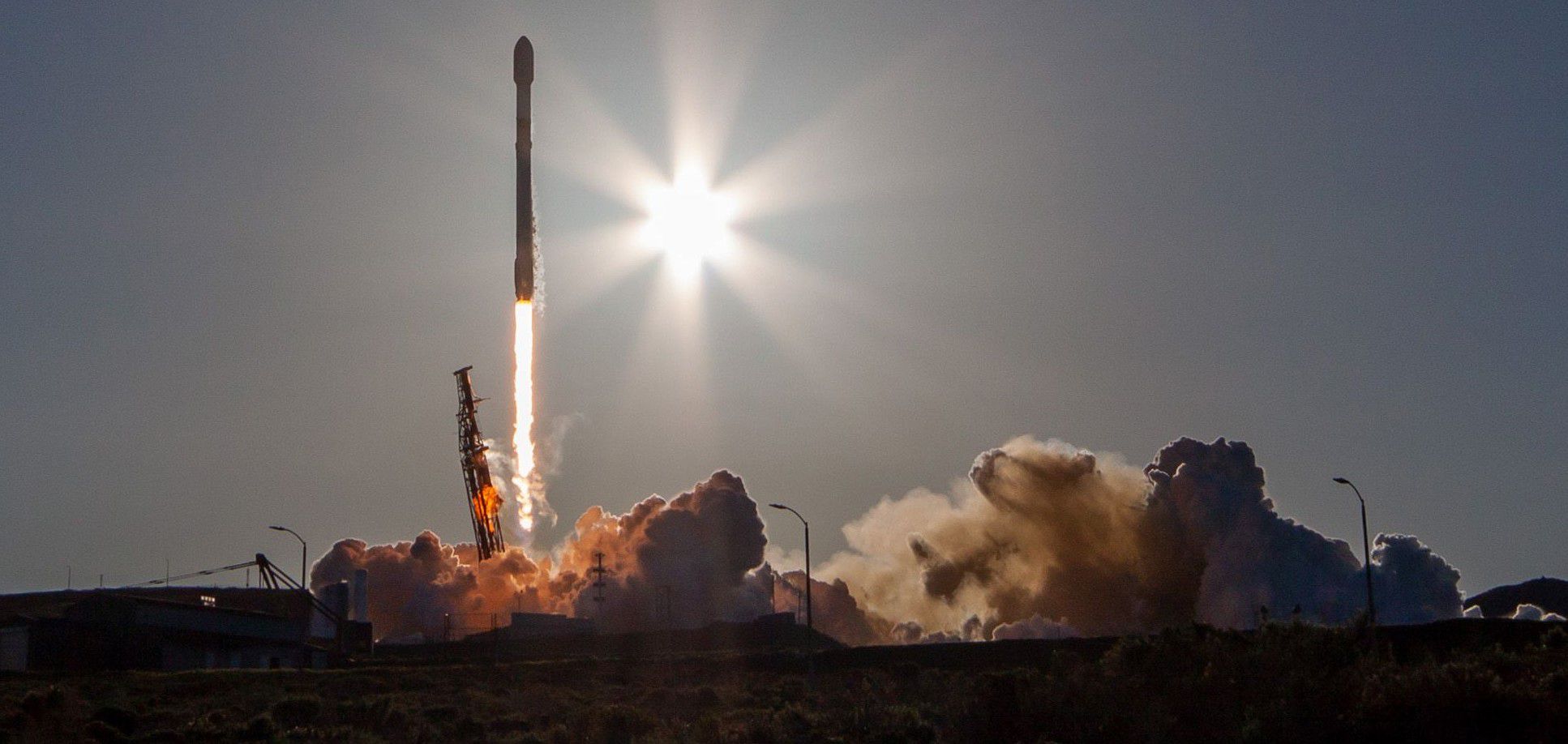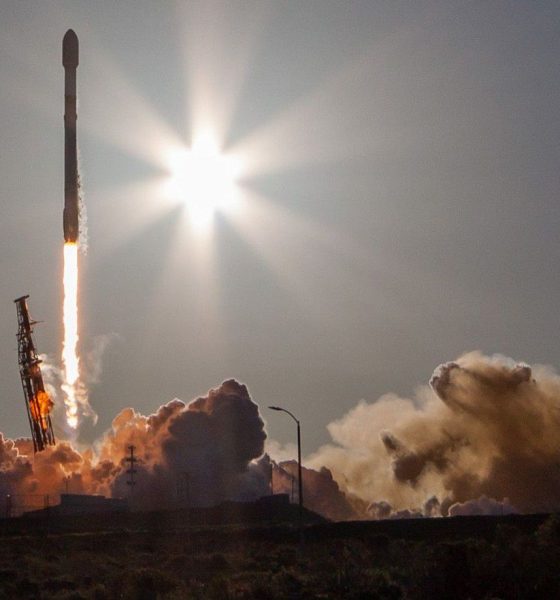SpaceX has launched its Falcon 9 rocket for the 200th time.
Measuring 70 meters (230 ft) tall and 3.7 meters (12 ft) wide, the 200th Falcon 9 rocket lifted off from SpaceX’s Vandenberg Space Force Base SLC-4E pad on January 31st, 2023. Beyond the statistical milestone, the Starlink 2-6 mission was a mostly ordinary launch of SpaceX’s own internet satellites.
However, SpaceX removed a pair of 310-kilogram (~680 lb) Starlink V1.5 satellites to make room for an ION orbital transfer vehicle (space tug) built by Italian space logistics company D-Orbit. ION SCV009 was fitted with four hosted payloads [PDF]: a solar sail designed to speed up satellite deorbiting, a prototype of a satellite deployment mechanism, a computer developed by Swiss students, and a memorial payload carrying cremated human remains.
About an hour after liftoff, Falcon 9 deployed ION SCV009. A batch of 49 Starlink satellites followed twenty minutes later, successfully completing Falcon 9’s 200th launch.
The update that's rolling out to the fleet makes full use of the front and rear steering travel to minimize turning circle. In this case a reduction of 1.6 feet just over the air— Wes (@wmorrill3) April 16, 2024
SpaceX’s Falcon 9 rocket debuted in June 2010, twelve and a half years ago. Considering that the company’s only prior experience was with a highly unreliable rocket about a magnitude smaller, Falcon 9 got off to an impressive start, suffering just one partial failure in its first five years of operation. A two-year period of pain followed when Falcon 9 suffered its one and only in-flight failure in June 2015 and a catastrophic explosion on the ground in September 2016.
However, since SpaceX returned its workhorse rocket to flight in January 2017, it hasn’t failed once. Starlink 2-6 was Falcon 9’s 177th consecutively successful launch – the most of any rocket in history. Against all odds, Falcon 9 has achieved that unprecedented reliability while simultaneously being the only partially-reusable orbital-class rocket in operation. Starlink 2-6 also marked SpaceX’s 93rd consecutively successful Falcon booster landing and 138th launch of a reused Falcon booster. Few rockets in history can claim to have launched 93 times without failure.
Fewer still have launched 200 times total or 199 times successfully. Depending on how one classifies similar variants, perhaps just half a dozen of the 100+ orbital rockets developed in the history of spaceflight have launched 200 times or more. It’s unlikely that SpaceX’s Falcon rocket family will ever come close to variants of certain Soviet-era rockets, one of which has flown almost 800 times, but it’s likely also true that it will be decades before another modern rocket comes close to matching Falcon.
SpaceX executives have made it clear that the company eventually wants to replace its partially-reusable Falcon rockets with Starship, a more capable fully-reusable rocket still in development, but Falcon is far from done. Falcon 9 took ten and a half years to complete its first 100 launches. The next 100 took a little over two years. SpaceX’s launch cadence continues to accelerate in the meantime. If the company gets its way, Falcon 9 could launch for the 300th time in the first half of 2024.
For the second time in a row, Starlink 2-6 was SpaceX’s seventh launch in one month. February could be even busier. SpaceX is set to kick off the second month of the year with another Starlink launch as early as the 2nd.

Elon Musk
Elon Musk and Tesla AI Director share insights after empty driver seat Robotaxi rides
The executives’ unoccupied tests hint at the rapid progress of Tesla’s unsupervised Robotaxi efforts.

Tesla CEO Elon Musk and AI Director Ashok Elluswamy celebrated Christmas Eve by sharing personal experiences with Robotaxi vehicles that had no safety monitor or occupant in the driver’s seat. Musk described the system’s “perfect driving” around Austin, while Elluswamy posted video from the back seat, calling it “an amazing experience.”
The executives’ unoccupied tests hint at the rapid progress of Tesla’s unsupervised Robotaxi efforts.
Elon and Ashok’s firsthand Robotaxi insights
Prior to Musk and the Tesla AI Director’s posts, sightings of unmanned Teslas navigating public roads were widely shared on social media. One such vehicle was spotted in Austin, Texas, which Elon Musk acknowleged by stating that “Testing is underway with no occupants in the car.”
Based on his Christmas Eve post, Musk seemed to have tested an unmanned Tesla himself. “A Tesla with no safety monitor in the car and me sitting in the passenger seat took me all around Austin on Sunday with perfect driving,” Musk wrote in his post.
Elluswamy responded with a 2-minute video showing himself in the rear of an unmanned Tesla. The video featured the vehicle’s empty front seats, as well as its smooth handling through real-world traffic. He captioned his video with the words, “It’s an amazing experience!”
Towards Unsupervised operations
During an xAI Hackathon earlier this month, Elon Musk mentioned that Tesla owed be removing Safety Monitors from its Robotaxis in Austin in just three weeks. “Unsupervised is pretty much solved at this point. So there will be Tesla Robotaxis operating in Austin with no one in them. Not even anyone in the passenger seat in about three weeks,” he said. Musk echoed similar estimates at the 2025 Annual Shareholder Meeting and the Q3 2025 earnings call.
Considering the insights that were posted Musk and Elluswamy, it does appear that Tesla is working hard towards operating its Robotaxis with no safety monitors. This is quite impressive considering that the service was launched just earlier this year.
Elon Musk
Starlink passes 9 million active customers just weeks after hitting 8 million
The milestone highlights the accelerating growth of Starlink, which has now been adding over 20,000 new users per day.

SpaceX’s Starlink satellite internet service has continued its rapid global expansion, surpassing 9 million active customers just weeks after crossing the 8 million mark.
The milestone highlights the accelerating growth of Starlink, which has now been adding over 20,000 new users per day.
9 million customers
In a post on X, SpaceX stated that Starlink now serves over 9 million active users across 155 countries, territories, and markets. The company reached 8 million customers in early November, meaning it added roughly 1 million subscribers in under seven weeks, or about 21,275 new users on average per day.
“Starlink is connecting more than 9M active customers with high-speed internet across 155 countries, territories, and many other markets,” Starlink wrote in a post on its official X account. SpaceX President Gwynne Shotwell also celebrated the milestone on X. “A huge thank you to all of our customers and congrats to the Starlink team for such an incredible product,” she wrote.
That growth rate reflects both rising demand for broadband in underserved regions and Starlink’s expanding satellite constellation, which now includes more than 9,000 low-Earth-orbit satellites designed to deliver high-speed, low-latency internet worldwide.
Starlink’s momentum
Starlink’s momentum has been building up. SpaceX reported 4.6 million Starlink customers in December 2024, followed by 7 million by August 2025, and 8 million customers in November. Independent data also suggests Starlink usage is rising sharply, with Cloudflare reporting that global web traffic from Starlink users more than doubled in 2025, as noted in an Insider report.
Starlink’s momentum is increasingly tied to SpaceX’s broader financial outlook. Elon Musk has said the satellite network is “by far” the company’s largest revenue driver, and reports suggest SpaceX may be positioning itself for an initial public offering as soon as next year, with valuations estimated as high as $1.5 trillion. Musk has also suggested in the past that Starlink could have its own IPO in the future.
News
NVIDIA Director of Robotics: Tesla FSD v14 is the first AI to pass the “Physical Turing Test”
After testing FSD v14, Fan stated that his experience with FSD felt magical at first, but it soon started to feel like a routine.

NVIDIA Director of Robotics Jim Fan has praised Tesla’s Full Self-Driving (Supervised) v14 as the first AI to pass what he described as a “Physical Turing Test.”
After testing FSD v14, Fan stated that his experience with FSD felt magical at first, but it soon started to feel like a routine. And just like smartphones today, removing it now would “actively hurt.”
Jim Fan’s hands-on FSD v14 impressions
Fan, a leading researcher in embodied AI who is currently solving Physical AI at NVIDIA and spearheading the company’s Project GR00T initiative, noted that he actually was late to the Tesla game. He was, however, one of the first to try out FSD v14.
“I was very late to own a Tesla but among the earliest to try out FSD v14. It’s perhaps the first time I experience an AI that passes the Physical Turing Test: after a long day at work, you press a button, lay back, and couldn’t tell if a neural net or a human drove you home,” Fan wrote in a post on X.
Fan added: “Despite knowing exactly how robot learning works, I still find it magical watching the steering wheel turn by itself. First it feels surreal, next it becomes routine. Then, like the smartphone, taking it away actively hurts. This is how humanity gets rewired and glued to god-like technologies.”
The Physical Turing Test
The original Turing Test was conceived by Alan Turing in 1950, and it was aimed at determining if a machine could exhibit behavior that is equivalent to or indistinguishable from a human. By focusing on text-based conversations, the original Turing Test set a high bar for natural language processing and machine learning.
This test has been passed by today’s large language models. However, the capability to converse in a humanlike manner is a completely different challenge from performing real-world problem-solving or physical interactions. Thus, Fan introduced the Physical Turing Test, which challenges AI systems to demonstrate intelligence through physical actions.
Based on Fan’s comments, Tesla has demonstrated these intelligent physical actions with FSD v14. Elon Musk agreed with the NVIDIA executive, stating in a post on X that with FSD v14, “you can sense the sentience maturing.” Musk also praised Tesla AI, calling it the best “real-world AI” today.










